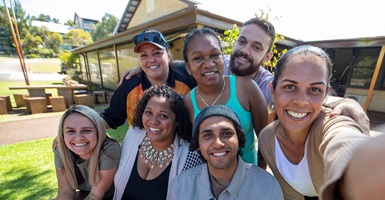There are few feelings more satisfying than picking fresh vegetables, fruit and herbs to cook and enjoy – even more so if you’ve helped to grow them yourself. A shared garden for your street or neighbourhood is much easier to start than you might think. And not just that: shared gardens build community and social cohesion, says Samantha Blair, a horticulture teacher at Chisholm who also runs a thriving community garden in Dromana.
“A community garden is about sharing time, resources and knowledge with other people,” she says. “The harvest is just a by-product”.
With just a little bit of planning, you could be enjoying and sharing your first harvest soon. Here’s how.
1. People power
Reach out to friends, neighbours and residents of your area to find out who might want to take part in developing a garden. Posting on your community’s Facebook page is a great way to start. This will help you gauge local interest and connect with others who are keen to join. You’ll also be able to identify those who have particular skills or experience that might come in handy.
It’s a good time to sharpen your communication skills, Samantha says.
“You need an ability to relate to people from diverse backgrounds and life experiences and bring them together for discussions. You may also need to liaise with councillors and council officers, and do so with diplomacy and respect.”
2. Rules rule
There are a number of different ways to set up a shared garden, so it will pay off to determine this at the earliest stages. For instance, will people have individual plots they tend themselves, or will everyone work on the joint space?
“Our Dromana garden is entirely communal with no ‘member's bed’. This is a very common model of many new community gardens in the last 10 years,” Samantha says.
Discuss with others how the space will operate and who will assume different responsibilities to ensure the garden runs smoothly from the start.
3. Location, location, location
The next big consideration is where you will plant the garden. Accessibility is key.
“Our main points for our land were that it is walking distance from the township, public transport, other sporting and recreational facilities and is bordered by residential housing,” Samantha says. “All very important considerations for the location of a community garden.”
If you have your eye on a vacant block of land, get in touch with the local council to find out if you might be able to develop the site. If not, they might be able to suggest other spaces that are available in your area.
4. Seeds, saplings and soil
You’ve got a location! That’s great - but what are you going to plant? You will need to take into account the size of the land you have, how much sunlight or shade it receives and your local climate. You will also need to decide on what particular mix of fruit, herbs and veggies you want to establish.
“Perennial vegetable and herbs that require less regular maintenance, especially shrubs, are great. Also fruit and nut trees,” Samantha says.
Samantha also advises having designated beds for annuals (they’re crops that turn over in a couple of months, like tomatoes) and designated beds and areas for perennials (they’re crops that permanently grow, like asparagus).
5. Harvest time!
There’s one final, but very important, thing you need to decide before breaking ground: who gets what and when? Essentially, can anyone help themselves whenever they like, or will the produce be picked and then shared among members? This is key to making sure your garden’s bounty gets shared between everyone and will help prevent any potential disputes.
The final thing to remember about a community garden is that it’s about exactly that: community.
“Almost no one comes to a community garden to ‘garden’. They can do that at home,” says Samantha. “People come to share their home harvest, meet new people, enjoy the company of like-minded people who share a common interest – growing food and being active members of their community – or to learn something new because they've never gardened and don't know where to start.”
So the harvest from your community garden can include one addition to the fruit, herbs and vegetables: relationships. And that’s something you can reap the benefits of for many years to come.


